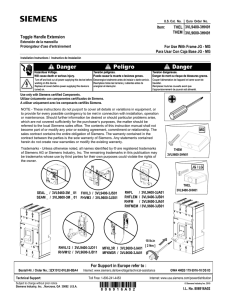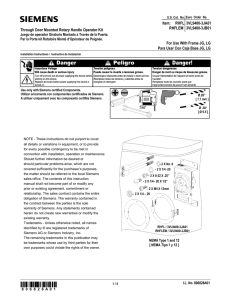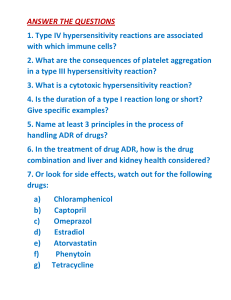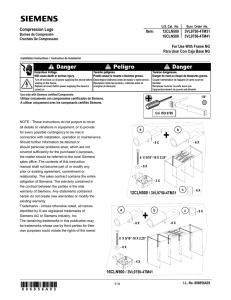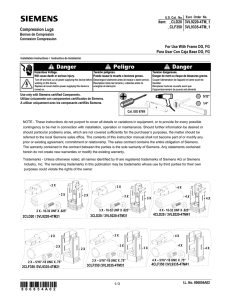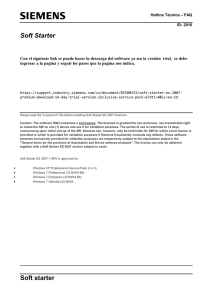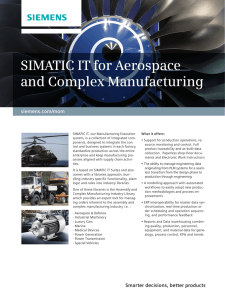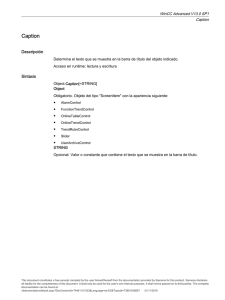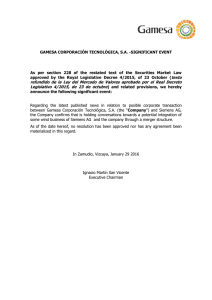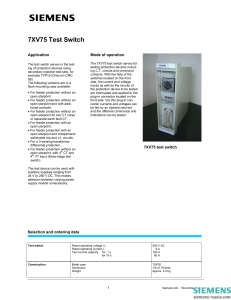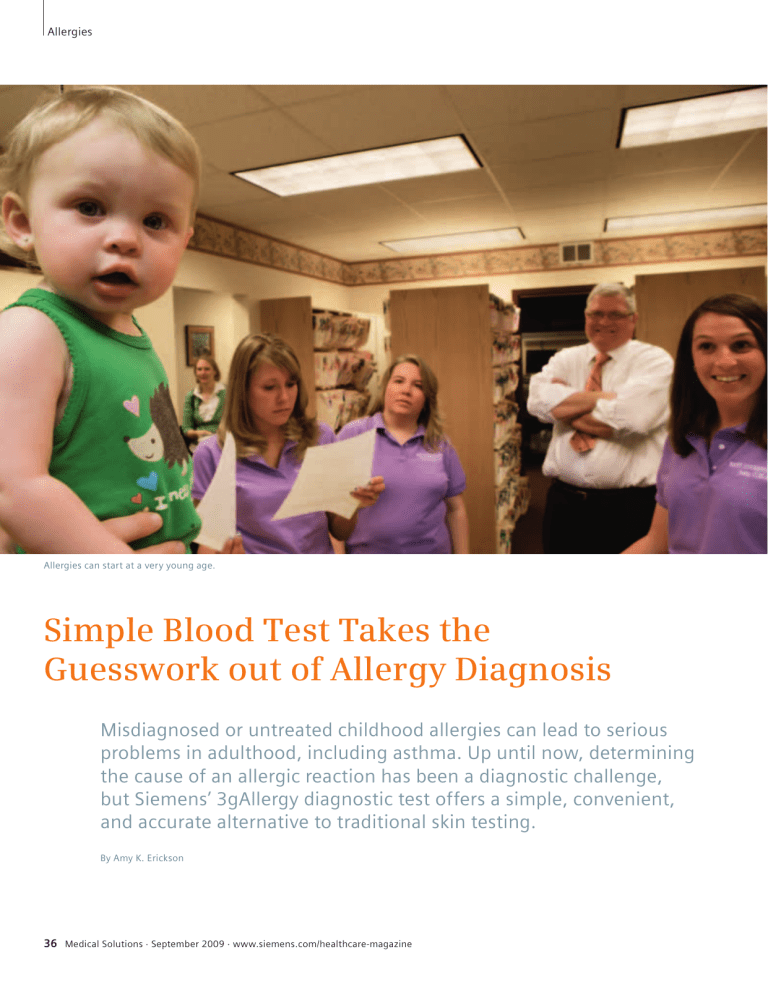
Allergies Allergies can start at a very young age. Simple Blood Test Takes the Guesswork out of Allergy Diagnosis Misdiagnosed or untreated childhood allergies can lead to serious problems in adulthood, including asthma. Up until now, determining the cause of an allergic reaction has been a diagnostic challenge, but Siemens’ 3gAllergy diagnostic test offers a simple, convenient, and accurate alternative to traditional skin testing. By Amy K. Erickson 36 Medical Solutions · September 2009 · www.siemens.com/healthcare-magazine Allergies For millions of adults and children worldwide, allergies are nothing to sneeze at. Symptoms like runny nose, watery eyes, coughing, and congestion are not just miserable, they can negatively impact an individual’s quality of life and cause decreased work and school productivity. “In many instances, the underlying cause of problems such as otitis media, sinusitis, and swollen tonsils might be an allergy rather than an infection,” says Terrence Zipfel, MD, an allergist and otorhinolaryngologist practicing in East Liverpool, Ohio, USA. His patients range from infants to adults who suffer from a variety of conditions affecting the ears, nose, and throat. Because respiratory disorders share so many common symptoms, correct diagnosis is key in order to give patients the right treatment. In order to do so, Zipfel uses the 3gAllergy™ diagnostic test from Siemens, a simple blood test that is setting new standards in allergy testing. According to the American Academy of Allergy, Asthma and Immunology, allergic diseases affect as many as 40 to 50 million Americans, and more than half of all U.S. citizens test positive to one or more allergens. Allergic rhinitis, an inflammation of the nasal passages usually associated with watery nasal discharge and itching of the nose and eyes, affects between ten and 30 percent of all adults and as many as 40 percent of children. In Europe, over 100 million people suffer from allergies.1 “Allergies can start when patients are not even a year old,” explains Markus Ollert, MD, an allergist with the Department of Dermatology and Allergy at the Clinical Research Division of Molecular and Clinical Allergotoxicology at the Technical University of Munich, Germany. An allergic reaction occurs when an allergen comes into contact with the body and the immune system produces an antibody called IgE. The IgE antibody triggers a chemical cascade that causes the various symptoms typical of an allergic reaction. The presence of these antibodies may also be an indicator of future allergies. “When a child reacts to milk proteins, for example, this causes the production of 1 http://eaaci.net/site/content.php IgE antibodies,” explains Ollert. “When these antibodies are present at such an early age, they also can be a predictor of developing inhalant allergies later in life.” Identification and Treatment For many, allergies are much more serious than itchy eyes and a runny nose. “Symptoms can affect the quality of sleep and manifest in the form of mental fatigue, which can affect a child’s schoolwork or possibly contribute to the potential misdiagnosis of an attention deficit disorder,” says Zipfel. “If allergies go untreated, there is a higher probability that the patient will develop additional, more severe symptoms, including asthma.” The progression from allergy to asthma is becoming a widespread health problem. Nearly 80 percent of all asthma cases are allergic asthma.2 Asthma accounts for one-quarter of all emergency room visits in the U.S. each year.3 In just 18 years, asthma has increased 100 percent in all age groups, and 160 percent in children up to four years of age.4 “It is important to use a test like 3gAllergy to give information to parents about allergies and asthma. When the 3gAllergy test detects an increase in allergen-specific IgE antibodies,” explains Ollert, “we have a good parameter that can be correlated with patient history and a physical examination to determine the allergens that cause the reaction. When we catch rhinitis early and give treatment such as immunotherapy at an early age, then it is possible to prevent the progression of rhinitis to asthma.” Determining what a person is allergic to can be a diagnostic challenge. Traditional allergy testing can be a long and painful process, with small amounts of suspected allergens being injected into the skin’s surface on the arm or back. If a patient is allergic to a substance, redness or swelling will appear at the site of the skin prick. http://www.allergypartners.com/hub/index.cfm/do/ home.services/siteid/22/page/services. last accessed Aug 29th, 2009 3 American Academy of Allergy Asthma and Immunology http://www.aaaai.org/media/resources/media_kit/asthma_ statistics.stm. last accessed Aug 29th, 2009 4 The US National Center for Health Statistics and The American Academy Of Otolaryngic Allergy. 2 The test can be uncomfortable for everyone, but especially for young children. The Siemens 3gAllergy test offers a convenient and accurate alternative or complement to skin testing. It is the first FDA-cleared third-generation blood test for allergies. The technology can perform a full range of tests on a small sample of blood to help the physician identify allergies to pet dander, foods, grasses, house dust, insects, molds, weeds, parasites, and other substances. The 3gAllergy test measures allergen-specific IgE antibodies found in the blood at lower concentrations than any other test available. “If allergies go untreated, there is a higher probability that the patient will develop additional, more severe symptoms, including asthma.” Terrence Zipfel, MD, Allergist and Otorhinolaryngologist, East Liverpool, Ohio, USA Medical Solutions · September 2009 · www.siemens.com/healthcare-magazine 37 Allergies Summary Challenge: • 40 to 50 million Americans affected by allergic diseases • Allergies associated with decreased school and work productivity, recognized as a public health concern6 • Progression from allergy to asthma, a growing problem worldwide • Skin prick allergy tests are uncomfortable and time consuming • Essential need to identify cause of an individual’s allergic reaction to guide treatment Siemens has the only platform solution that offers blood testing for allergies along with routine and specialized immunoassay testing on its IMMULITE 2000 XPi system. Once allergies are identified, there are several possible treatments. It could be as simple as controlling house dust with filters, avoiding allergy-causing foods, limiting outdoor activities or minimizing exposure to animals. Additionally, patients may use medications to control symptoms. Immunotherapy, also called allergy shots, is used to reduce sensitivity to pollens, dust, mold, and other agents. Immunotherapy can reduce the risk of an allergy progressing to asthma.5 Solution: • 3gAllergy test can identify allergic reaction with a large menu of allergens available, including food, animals, dust mites, molds, and a wide range of seasonal allergies • Only a small amount of blood needed rather than numerous skin pricks • Performing test in conjunction with physical examination and evaluation of the patient’s medical history The 3gAllergy Advantage Result: • Improved patient care • Earlier allergy detection and treatment could prevent the onset of chronic allergic conditions and progression to asthma • Fast, accurate results increase office efficiency • Identification of allergen allows treatment that may include eliminating the environmental cause, using medications to control symptoms, or immunotherapy to reduce sensitivity The 3gAllergy test, plus a physical examination and a detailed patient history, allows a physician to make an allergy diagnosis and determine which treatment steps are most appropriate. Siemens’ proprietary liquid allergens are the key to making the 3gAllergy test sensitive, specific, and reliable. The liquid allergens increase the availability of binding sites and their accessibility to allergen-specific IgE antibodies in the patient‘s blood. The instrument‘s enzyme-enhanced chemiluminescent signal detection provides increased sensitivity, and the proprietary wash technique enhances specificity. In 2005, Ollert published a paper in Clinical Chemistry that compared the 3gAllergy test with another blood allergy test on the market and the skin prick test. “We found that the Siemens test is more sensitive when compared to the other methods,” explains Ollert. “Compared to 5 6 Lenney, W. The burden of pediatric asthma. Pediatr Pulmonol. 1997;15:13-16. Johnstone DE, Dutton A. The value of hyposensitization therapy for bronchial asthma in children – a 14-year study. Pediatrics. 1968 Nov;42(5):793-802. 38 Medical Solutions · September 2009 · www.siemens.com/healthcare-magazine skin testing, the 3gAllergy system shows a very high degree of sensitivity. Skin testing, however, is just a global response. With the Siemens system, you get a clearcut, controlled result.” According to Zipfel, “Empirical diagnosis is practiced widely for allergy and sinus conditions, and there’s a lot of inaccuracy in the process. Our practice has addressed this problem by introducing the 3gAllergy test in order to use solid measures to evaluate the origin of symptoms and receive objective data.” Zipfel has been using the 3gAllergy test in his practice for nearly four years and sees about 150 to 180 patients per week. “The results that we can obtain from one needle stick are enormous,” he says. “It can have a lifelong impact on a child and provide lifelong benefits. Although the test can help diagnose allergies, it can also help us rule out allergies as a source of symptoms. If that is the case, then other treatments such as antibiotics are prescribed.” Zipfel has also noticed that his staff benefits from using the 3gAllergy system. “From a staffing point of view, less time is needed to conduct the test. This increased efficiency in our office has enabled us to see more patients and perform a higher number of tests.” Siemens has the only platform solution that offers blood testing for allergy along with routine and specialized immunoassay testing on its IMMULITE® 2000 and new XPi systems. Send-out costs can be eliminated and send-out revenue can be captured by adding allergy testing. Compared to standalone instruments for immunoassay and allergy testing, the Allergies IMMULITE platform reduces footprint, improves productivity and turnaround time, and is a means for partner labs to capture send-out revenue. “As my practice grew over the years, I felt pressure to find a way to take care of more patients,” explains Zipfel. “When sending out samples for analysis, it was not unusual for the turnaround time to be two to three weeks in order to get the results. I felt powerless in this process. Once the IMMULITE 2000 analyzer was installed here in the practice, I found that, if necessary, I could have turnaround in a little over an hour.” Ollert and his team in Germany were one of the first labs in the world to use the 3gAllergy technology. “It has been running smoothly ever since the IMMULITE 2000 was installed eight years ago. It’s a very robust technology,” says Ollert. “The analyzer runs several days a week for around eight hours a day, and we’ve had no problems. The lab technicians can walk away and do other things, which allows them to be very flexible with their schedule in the lab.” Siemens is the only clinical diagnostics provider that offers allergy testing platforms that can easily be integrated into track-based laboratory automation solutions. The 3gAllergy on IMMULITE works well for both Ollert’s large-scale lab and for Zipfel’s patient practice. “Some have said that a one-man solo practice cannot use this sort of instrumentation and technology,” says Zipfel, “but I think we’re proving them wrong. If I can make it work, then a lot of other people can, too. I think the 3gAllergy technology has increased the efficiency of the office and the quality of patient care, and has ultimately enabled us to take better care of more patients.” Amy K. Erickson is a Chicago-based writer specializing in medicine, science, and biotechnology. Further Information New Book Helps Kids Understand Allergies Siemens Healthcare and the Walt Disney Company have teamed up to create a children’s book to educate kids and parents about the diagnosis and management of allergies. Mickey and the Giant Kachoo! featuring Disney’s Mickey Mouse, highlights the 3gAllergy test from Siemens, which can help identify allergens that trigger allergic reactions. This test uses a small amount of blood, making it simpler than a traditional skin prick test, and carries no risk of a severe reaction. According to the American Academy of Allergy, Asthma and Immunology, the prevalence of food allergies among children under the age of 18 increased 18 percent from 1997 to 2007. Kids with a food allergy are two to four times more likely to have conditions such as other allergies and asthma, making it important to be aware of all diagnosis and treatment options available. “We want parents to know there is a simple option for their children to be tested for allergic reactions,” comments Dave Hickey, Executive Vice President Central Laboratory and Global Research and Development, Siemens Healthcare Diagnostics. In the book, Mickey and the gang find out that Willie the Giant has allergies. “By reading a story with familiar Disney characters, children and parents will learn that allergies are common and there are options to help diagnose and manage them,” says Hickey. The Siemens-Disney Alliance is a 12-year strategic technology and marketing alliance that paves the way for collaboration across several areas, including child education and awareness in healthcare. Mickey and the Giant Kachoo! was developed for the clinical laboratory and physician communities as part of an initiative that uses Disney storytelling to help kids understand health issues. Previously, Siemens and Disney, both known for their commitment to innovation, collaborated on a healthy hearing kit for kids that is distributed by physicians and healthcare clinics. The alliance is a reflection of Siemens dedication to the delivery of quality healthcare and Disney’s legacy of caring for children. Mickey and the Giant Kachoo! will be released in late 2009, with exclusive distribution for laboratories and clinicians. The first print run will be in English. To view a copy of the book online, go to www.siemens.com/allergy-Disney www.siemens.com/3gAllergy Medical Solutions · September 2009 · www.siemens.com/healthcare-magazine 39 Global Siemens Headquarters Global Siemens Healthcare Headquarters Siemens AG Wittelsbacherplatz 2 D-80333 Munich Germany Siemens AG Healthcare Sector Henkestrasse 127 D-91052 Erlangen Germany Telephone: +49 9131 84-0 www.siemens.com/healthcare www.siemens.com/healthcare-magazine Order No. A91CC-00035-M1-7600 | Printed in Germany | CC 00035 ZS 090940. | ISSN 1614-2535 | © 09.09, Siemens AG On account of certain regional limitations of sales rights and service availability, we cannot guarantee that all products included in this brochure are available through the Siemens sales organization worldwide. Availability and packaging may vary by country and is subject to change without prior notice. Some/All of the features and products described herein may not be available in the United States. Local Contact Information The information in this document contains general technical descriptions of specifications and options as well as standard and optional features which do not always have to be present in individual cases. Canada: Siemens Canada Limited Healthcare Sector 2185 Derry Road West Mississauga ON L5N 7A6 Canada Telephone: +1 905 819-5800 Siemens reserves the right to modify the design, packaging, specifications, and options described herein without prior notice. Please contact your local Siemens sales representative for the most current information. Note: Any technical data contained in this document may vary within defined tolerances. Original images always lose a certain amount of detail when reproduced. Asia/Pacific: Siemens Medical Solutions Asia Pacific Headquarters The Siemens Center 60 MacPherson Road Singapore 348615 Telephone: +65 9622-2026 Europe/Africa/Middle East: Siemens AG, Healthcare Sector Henkestr. 127, 91052 Erlangen Germany Telephone: +49 9131 84-0 Latin America: Siemens S.A., Medical Solutions Avenida de Pte. Julio A. Roca No 516, Piso 7 C1067ABN Buenos Aires Argentina Telephone: +54 11 4340-8400 USA: Siemens Medical Solutions U.S.A., Inc. 51 Valley Stream Parkway Malvern, PA 19355-1406 USA Telephone: +1 888 826-9702
